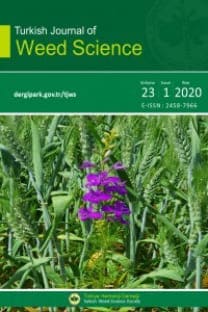Asteraceae Ailesine Ait Farklı Türlerin Antibakteriyel Aktivitesinin Belirlenmesi
Son yıllarda alternatif tıp uygulamalarında bitkilerin kullanımı artmıştır. Sentetik kimyasalların görülen zararlı etkilerinden dolayı
tıbbi bitkilerden elde edilen özütlerin antioksidan, antibakteriyel ve antifungal özellikleri araştırılmaktadır. Bu çalışmada, Amasya
ilinde farklı ekolojik şartlarda yayılış gösteren bazı bitki türlerinin antibakteriyel aktiviteleri araştırılmıştır. Asteraceae ailesine ait
Anthemis tinctorial L., Matricaria chamomilla L. ve Achillea biebersteinii Afan türlerinin metanolik özütleri sokslet cihazı
yardımıyla elde edilmiştir. Elde edilen özütlerin antibakteriyal aktivitesi disk difüzon ve mikrodilüsyon yöntemi ile belirlenmiştir.
Antibakteriyel aktivite için Staphylococcus aureus, Escherichia coli, Klebsiella pneumoniae, Pseudomonas aeruginosa ve
Salmonella enteritidis standart suşları kullanılmıştır. Bu çalışmada, bitki özütleri kontrol olarak kullanılan antibiyotik grubuyla
karşılaştırıldığında antibakteriyel etkiye sahip olduğu gözlemlenmiştir. Disk difüzyon yönteminin sonuçlarına göre, en yüksek
antibakteriyel etki sırasıyla A. tinctorial, M. chamomilla ve A. biebersteinii olarak belirlenmiştir. Mikrodilüsyon yönteminde bitki
özütlerinin konsantrasyon aralığı 6,25 - 50 mg/mL olacak şekilde ayarlanmıştır. Sonuç olarak çalışmada kullanılan bitki özütlerinin
alternatif tedavi amacıyla kullanılabileceği ve daha sonra yapılacak antibakteriyel çalışmalara yön göstereceği düşünülmektedir.
Anahtar Kelimeler:
Asteraceae, Disk difüzyon, Mikro dilüsyon
Antibacterial Activity Determination of Different Species Belonging to Asteraceae Family
The use of herbs as alternative medicine has increased dramatically in the last years. In recent years, due to the harmful effects of
chemical drugs are frequently observed antioxidant, antibacterial and antifungal properties of extracts which derived from plants
and they have been used in medicine. In this study, aim was investigated the antibacterial activities of some weed species which
distributed to ecologically for different conditions. The antibacterial activities of Anthemis tinctorial L., Matricaria chamomilla L.
and Achillea biebersteinii Afan. which belonging to Asteraceae family from Amasya province were determined by using disc
diffusion and micro dilution methods. The methanolic extracts of these weeds were prepared with Soxhlet Extractor. The extracts
were tested against standard strains of Staphylococcus aureus, Escherichia coli, Klebsiella pneumoniae, Pseudomonas aeruginosa
and Salmonella enteritidis. In this study, it was observed that weed extracts had antibacterial effects when they compared with
control antibiotic group. the bacteria to be tested are sensitive to the control group antibiotics. According to the results of disc
diffusion method, the highest antibacterial effect was identified A. tinctorial, M. chamomilla and A. biebersteinii respectively. The
microdilution method was studied concentration range from 6.25 - to 50 mg/mL. In this context, it can be considered that these
weed species are used as an alternative treatment and can lead to later antibacterial studies.
Keywords:
Asteraceae, Disc diffusion, Micro dilution,
___
- Applequist WL., Moerman DE. (2011). Yarrow (Achillea millefolium L.): a neglected panacea. A review of ethnobotany, bioactivity, and biomedical research. Economic Botany, 65:209–225.
- Badescu M., Badulescu O., Badescu L., Ciocoiu M. (2015). Effects of Sambucus nigra and Aronia melanocarpa extracts on immune system disorders within diabetes mellitus. Pharmcology Biology, 53:533–539.
- Baytop T. (1999). Therapy with Plants in Turkey; Past and Present. 2nd ed., Nobel Tıp Press, Istanbul (in Turkish).
- Borkataky M., Kakoty BB., Saikia LR. (2013). Proximate analysis and antimicrobial activity of Eclipta alba (l.) hassk. - a tradıtıonally used herb. International Journal of Pharmacy and Pharmaceutical Sciences. 5:149-154.
- Clinical and Laboratory Standards Institute (CLSI) (2010). Performance Standards for Antimicrobial Susceptibility Testing; Twentieth Informational Supplement. M100-S20, Vol:30 No: 1.
- Emanuel V., Adrian V., Sultana N., Svetlana C. (2011). Antioxidant and Antimicrobial Activities of Ethanol Extracts of Cynara Scolymus (Cynarae folium, Asteraceae Family). Tropical Journal of Pharmaceutical Research, 10:777-783.
- Farbood MI., Mac NJH., Ostavar K. (1976). Effects of rosemary spice extractive on growth of microorganisms in meats. Journal Milk Food Technology, 39:675–679.
- Kianbakht S., Jahaniani F. (2003). Evaluation of antibacterial activity of Tribulus terrestris L. growing in Iran. Iran Journal Pharmacolgy Therapeutics. 2:22–24.
- Lu XM., Wang JX. (2003). Research advancement on Bergenia genus plants. Journal China Medical Mater, 26:58–60.
- Nemeth E., Bernath J. (2008). Biological activities of yarrow species (Achillea spp.). Current Pharmceutical Design, 14:3151–3167.
- Ong ES., Cheong JSH., Goh D. (2006). Pressurized hot water extraction of bioactive or marker compounds in botanicals and medicinal plant materials. Journal of Chromatography A, 1112:92–102.
- Salem MZM., Ali HM., El-Shanhorey NA., Ahmed AM. (2013). Evaluation of extracts and essential oil from Callistemon viminalis leaves: Antibacterial and antioxidant activities, total phenolic and flavonoid contents. Asian Pacific Journal of Tropical, 785-791.
- Si XT., Zhang ML., Shi QW., Kiyota H. (2006). Chemical constituents of the plants in the genus Achillea. Chemical Biodiversity, 3:1163–1180.
- Ulukanli Z., Ulukanli S., Ozbay H., Ilcim A., Tuzcu M. (2005). Antimicrobial activities of some plants from the Eastern Anatolia region of Turkey. Pharmacology Biology, 43:334-339.
- ISSN: 1303-6491
- Başlangıç: 1998
- Yayıncı: Türkiye Herboloji Derneği
Sayıdaki Diğer Makaleler
Türkiye Florası için Yeni Yabancı Ot Türü Kaydı Ipomoea hederifolia L. (Convolvulaceae)
Levent HANÇERLİ, Muhammet Uğurcan AYATA, Halil ÇAKAN, Feyzullah Nezihi UYGUR, Sibel UYGUR
Mehmet Salih GÖKSU, Onur KOLÖREN
Muş İlinde Buğday Ürününe Karışan Yabancı Ot Tohumları
Melike MELİKE BOZKURT1, Nihat TURSUN
Farklı Su Miktarları ile Uygulanan Organik Herbisitlerin Yabancı Otların Kontrolü Üzerindeki Etkisi
Onur KOLÖREN, W. Thomas LANINI
Ordu İli Rubus Türlerinin Moleküler Tanısı ve Filogenisi
Asteraceae Ailesine Ait Farklı Türlerin Antibakteriyel Aktivitesinin Belirlenmesi
